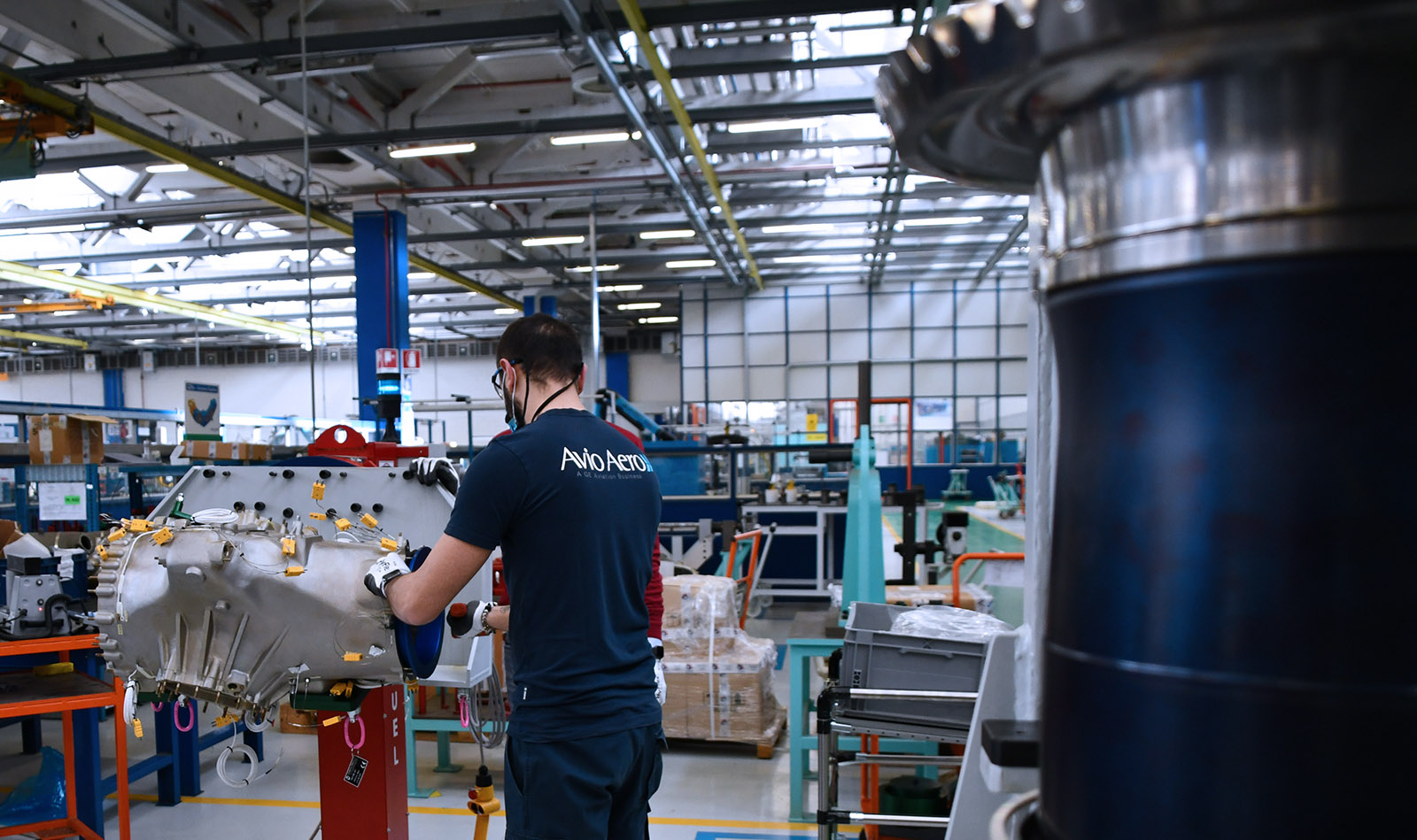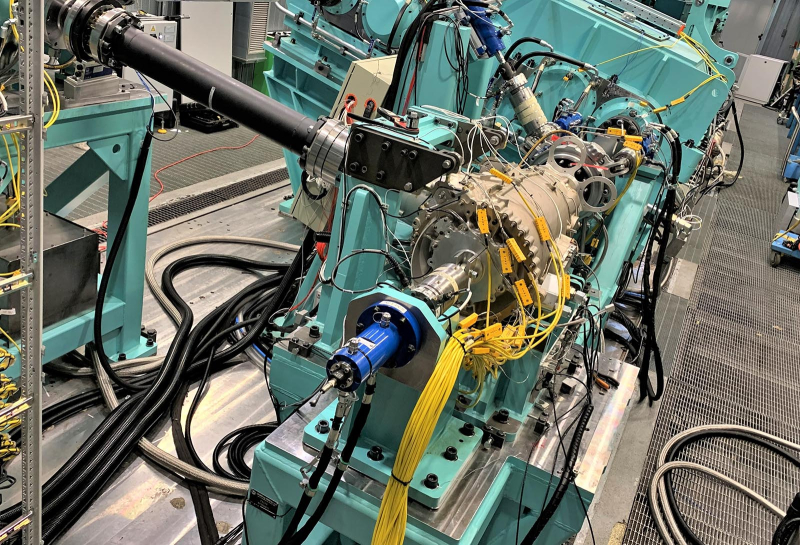Future
The RACER comes to life
The next-generation hybrid helicopter is approaching the flight campaign, with its advanced transmission systems developed and produced in a special collaboration with Airbus Helicopters.
Apr 2022
Efficient, super-fast and really cutting edge. The RACER, with its hybrid helicopter-plane design, began to take shape at the Airbus Helicopters assembly plant at Donauwörth, in Bavaria. It has now been moved to the company's headquarters in Marignane, southern France, where the structure will be completed and fitted with an engine and a state-of-the-art transmission system.
The project was developed under the aegis of Clean Sky 2, the largest public-private R&D partnership program with the EU, which is now preparing for its next phase: Clean Aviation. Right from the start, the Racer has proved to be a radical advance for the specialists in accessory gearboxes and power transmissions at Avio Aero. In fact, the Main Gearbox (MGB) that connects the engine to the helicopter blades were designed and constructed in tight collaboration with Airbus Helicopter.
"This co-development project was carried out in a spirit of collaboration and mutual support, endeavoring at every stage to harness and bring together the best practices and expertise of both teams," said Marinella Marconi, RACER Technical Leader at Avio Aero. "We are now entering the busy production stage for the MGB, with on-going exchanges between our teams and our suppliers. This involves the 5 sub-modules that make up the MGB, and is a real challenge for the whole assembly and instrumentation team at our Rivalta plant. We are resolving the details and complexities as we go along, working with the various company managers as well as with the customer. In addition to the MGB, we are designing and producing the lateral gearboxes for the propellers on the RACER's two wings."
The lateral gearboxes (LGBs) are able to spawn 1MW of power, and represent a cutting-edge product exclusively developed for the RACER. As Andrea Demarin, Racer Program Manager at Avio Aero, explained: "We finished assembling the first lateral gearbox module - the one on the left - last month. This will now be subjected to flight clearance tests, required for the aircraft to be authorized for flight. These flight clearance tests will be carried out on special purpose-built benches that have been set up in the hangars at the Sangone Experimental Center."
This is going to be an important moment, as it represents the culmination of many months of work in design, development and finally industrial production, conducted together with Airbus Helicopters and with the help of other SMEs. As Julien Guitton, RACER Program Leader at Airbus Helicopters, pointed out: "Our partnership, our integrated team, has really proved to be a unique model of collaboration in a highly competitive environment. The way we harmonized our working methods protected our respective IPs, requiring efforts from both teams. These efforts are now bearing fruit, with practical results that are now being tested and will soon be in flight. During the pandemic, our teams were constantly in touch and, with the help of digital models, we were able to limit the impact on progress."
The products that have been developed, produced and tested by Avio Aero for the RACER form the basis of the new strategic technological system, defined by the company as the Helo Ecosystem. Moreover, the RACER will also benefit from the innovative solutions developed for the Catalyst advanced turboprop engine (likewise, the latter includes several innovative Clean Sky2 technologies and already undergoing flight tests). This is the case of the ACOC (air cooler oil cooler) heat exchanger of the LGBs, that was designed and manufactured using additive technology just like it was that of the new Catalyst engine.
"The tests carried out at Sangone are able to subject the LBG to the entire power spectrum, also applying external loads that simulate those on the propellers in flight as well as the flows of cooling air to the ACOC exchanger integrated in the LGB, and even simulating attitude during flight maneuvers over the entire envelope (the so-called attitude testing)", Demarin explained. “Manufacturing the ACOC with additive technology has allowed us to design a highly integrated and compact lubrication and cooling system: this can fit in the space between the housing of the LGB and the aircraft nacelle, and integrates functions of the oil system in addition to heat exchange. It’s a single component integrating multiple functions."
"The tests carried out at the Sangone Center are able to subject the LBG to the entire power spectrum, also applying external loads that simulate those on the propellers in flight"
The Avio Aero laboratory, in partnership with the Politecnico (TAL), studied these solutions with DMLM (direct metal laser melting) technology, the same with which the Catalyst components are 3D printed (some developed in the same way at the laboratory on the campus of the University of Turin). “We applied what we learned from the Catalyst to resolve the design, manufacturing and flight clearance issues related to the Racer" says Demarin.
The RACER will be able to cruise at speeds of up to 220 knots (400 km/h), with a range of more than 400 nautical miles. “The aim is to demonstrate the capabilities of the RACER in missions where speed is crucial such as for passenger transport, emergency medical and health services, and search and rescue. Of course, the purpose of the demonstrator is also to demonstrate the reduction in emissions (CO2, NOx and noise) and the cost-benefit ratio”, Guitton adds.
Avio Aero therefore has high ambitions and expectations for the RACER. The concentration of new technologies with a direct impact on the speed, reliability and aerodynamics of the aircraft is based on development strategies that focus on new materials for gears and transmission parts, and on additive technology.
Other European teams also played an important role in the development of the RACER, as Marconi explains. “The engineering team of Avio Aero Polska was of particular help: our colleagues in Bielsko are responsible for the design of the accessory gearboxes connected to the MGB and were involved in the design of the central gearbox itself, as well as in the safety and reliability analysis. For the first time, they have distinguished themselves with a helicopter product. In this case, one unlike any other."
The RACER will now be tested for the Clean Sky2 program, after which it will be deployed according to its “multi-role” nature in aerial applications where speed makes the difference. "We want to continue with a technology-driven approach, in order to stimulate the market of civil aviation and attract potential customers," Guitton said. "The flight test campaign will help us define the details and optimize the results that will help us shape the hybrid helicopter of the future."
Images of the RACER in page are courtesy of Airbus Helicopters ©2022







